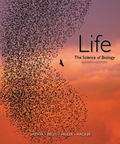
Concept explainers
To review:
The decrease in the number of radio-labeled cells in the zones of cell division and cell elongation over the time.
Introduction:
The undifferentiated mass of cells that has the capability to divide and give rise to a new plant is called as meristems. The meristems located at the apex regions are referred to as the apical meristems that are found at the root apex (root apical meristem) and shoot apex (shoot apical meristem).
Explanation of Solution
Introduction:
Root apical meristem (RAM) is responsible for the generation of cells that help in the development of root for the absorption of water from the soil. The tip of the RAM contributes to the formation of the root cap, which protects the soft tissues of root from damage and also helps in the penetration into the soil. The middle portion of RAM is the quiescent center, which consists of a mass of cells that are held at the G0 stage of the cell cycle, but can enter G1 phase and undergo division when required.
The apical portion of the RAM gives rise to three distinct zones. The zone of cell division is present just above the quiescent center, which possesses the actively dividing cells giving rise to primary root tissues. Above this, zone of elongation is present where the cells are continuously elongating in size. The zone of cell maturation is present just above the elongation zone. Here, the cells are not dividing anymore and get matured and differentiated to perform a specialized function.
In an experiment the growing root tips of the plant were incubated in radio-labeled thymidine solution to identify the dividing cells in roots, the thymidine is incorporated in DNA and gets labeled. Later, when the labeled cells were put in the solution containing nonlabeled thymine, the number of labeled cells decreased in the zone of division and elongation of the root. This is because the cells of zone of division and elongation actively took up the labeled
Hence, there was a decrease in the labeled cells in the division and elongation zones and increase in the zone of maturation when incubated long in the solution of nonlabeled thymidine solution. This is so because during the
Want to see more full solutions like this?
Chapter 33 Solutions
EBK LIFE: THE SCIENCE OF BIOLOGY
- Describe the principle of homeostasis.arrow_forwardExplain how the hormones of the glands listed below travel around the body to target organs and tissues : Pituitary gland Hypothalamus Thyroid Parathyroid Adrenal Pineal Pancreas(islets of langerhans) Gonads (testes and ovaries) Placentaarrow_forwardWhat are the functions of the hormones produced in the glands listed below: Pituitary gland Hypothalamus Thyroid Parathyroid Adrenal Pineal Pancreas(islets of langerhans) Gonads (testes and ovaries) Placentaarrow_forward
- Describe the hormones produced in the glands listed below: Pituitary gland Hypothalamus Thyroid Parathyroid Adrenal Pineal Pancreas(islets of langerhans) Gonads (testes and ovaries) Placentaarrow_forwardPlease help me calculate drug dosage from the following information: Patient weight: 35 pounds, so 15.9 kilograms (got this by dividing 35 pounds by 2.2 kilograms) Drug dose: 0.05mg/kg Drug concentration: 2mg/mLarrow_forwardA 25-year-old woman presents to the emergency department with a 2-day history of fever, chills, severe headache, and confusion. She recently returned from a trip to sub-Saharan Africa, where she did not take malaria prophylaxis. On examination, she is febrile (39.8°C/103.6°F) and hypotensive. Laboratory studies reveal hemoglobin of 8.0 g/dL, platelet count of 50,000/μL, and evidence of hemoglobinuria. A peripheral blood smear shows ring forms and banana-shaped gametocytes. Which of the following Plasmodium species is most likely responsible for her severe symptoms? A. Plasmodium vivax B. Plasmodium ovale C. Plasmodium malariae D. Plasmodium falciparumarrow_forward
- please fill in missing parts , thank youarrow_forwardplease draw in the answers, thank youarrow_forwarda. On this first grid, assume that the DNA and RNA templates are read left to right. DNA DNA mRNA codon tRNA anticodon polypeptide _strand strand C с A T G A U G C A TRP b. Now do this AGAIN assuming that the DNA and RNA templates are read right to left. DNA DNA strand strand C mRNA codon tRNA anticodon polypeptide 0 A T G A U G с A TRParrow_forward
 Human Heredity: Principles and Issues (MindTap Co...BiologyISBN:9781305251052Author:Michael CummingsPublisher:Cengage Learning
Human Heredity: Principles and Issues (MindTap Co...BiologyISBN:9781305251052Author:Michael CummingsPublisher:Cengage Learning Biology (MindTap Course List)BiologyISBN:9781337392938Author:Eldra Solomon, Charles Martin, Diana W. Martin, Linda R. BergPublisher:Cengage Learning
Biology (MindTap Course List)BiologyISBN:9781337392938Author:Eldra Solomon, Charles Martin, Diana W. Martin, Linda R. BergPublisher:Cengage Learning Human Biology (MindTap Course List)BiologyISBN:9781305112100Author:Cecie Starr, Beverly McMillanPublisher:Cengage Learning
Human Biology (MindTap Course List)BiologyISBN:9781305112100Author:Cecie Starr, Beverly McMillanPublisher:Cengage Learning Concepts of BiologyBiologyISBN:9781938168116Author:Samantha Fowler, Rebecca Roush, James WisePublisher:OpenStax College
Concepts of BiologyBiologyISBN:9781938168116Author:Samantha Fowler, Rebecca Roush, James WisePublisher:OpenStax College Biology Today and Tomorrow without Physiology (Mi...BiologyISBN:9781305117396Author:Cecie Starr, Christine Evers, Lisa StarrPublisher:Cengage Learning
Biology Today and Tomorrow without Physiology (Mi...BiologyISBN:9781305117396Author:Cecie Starr, Christine Evers, Lisa StarrPublisher:Cengage Learning





